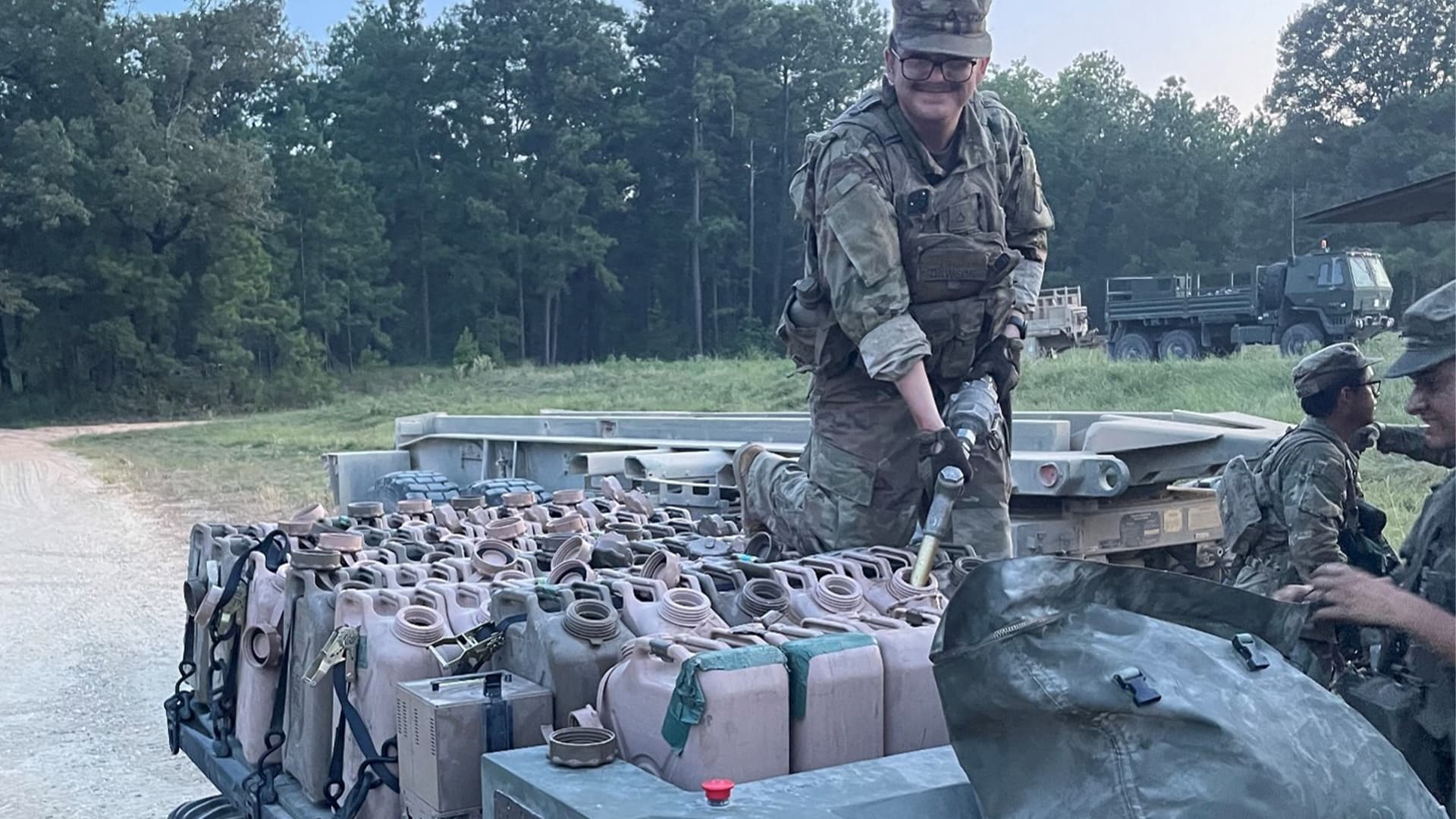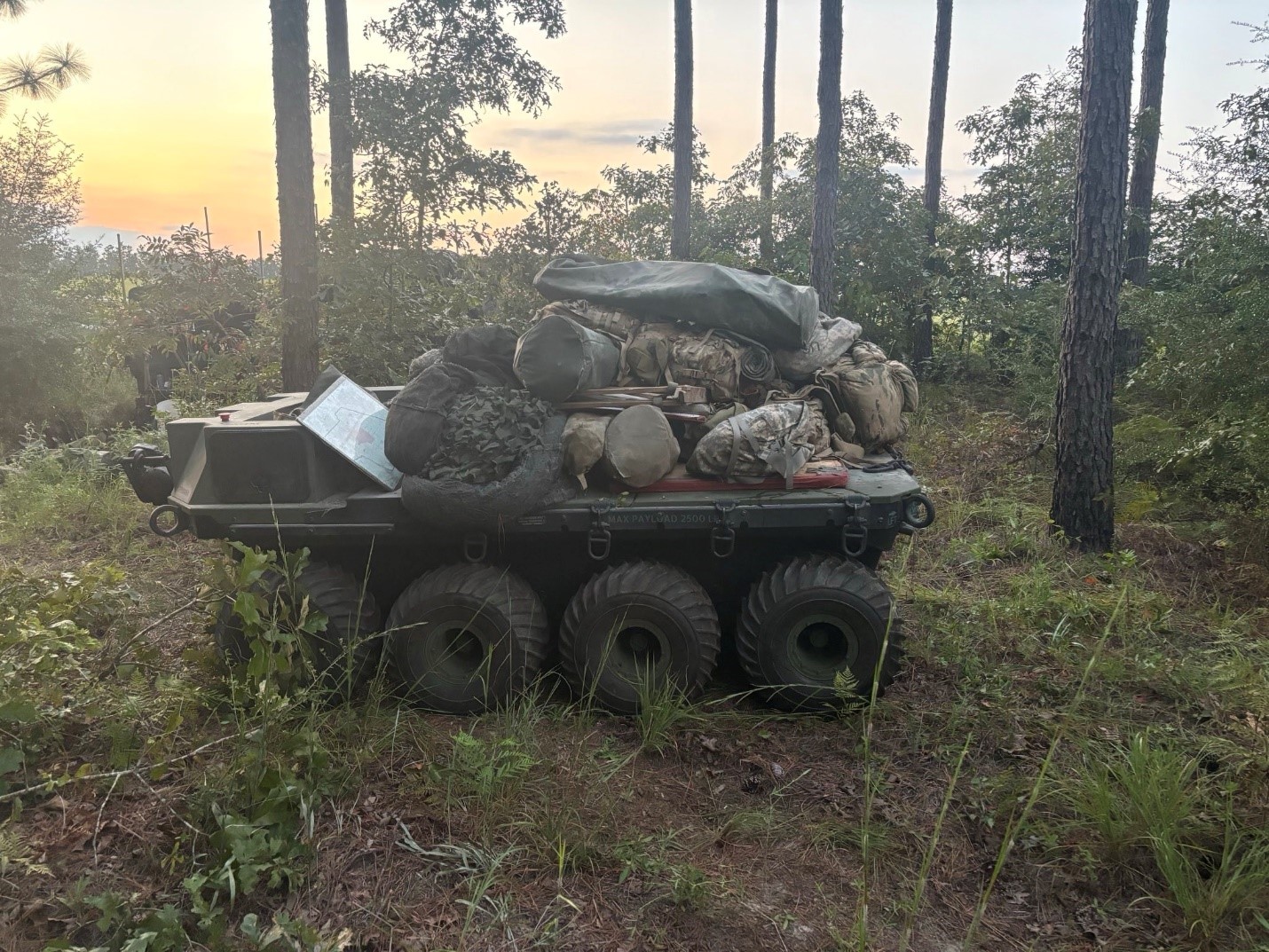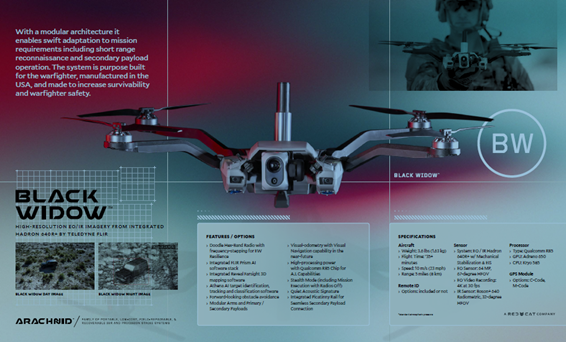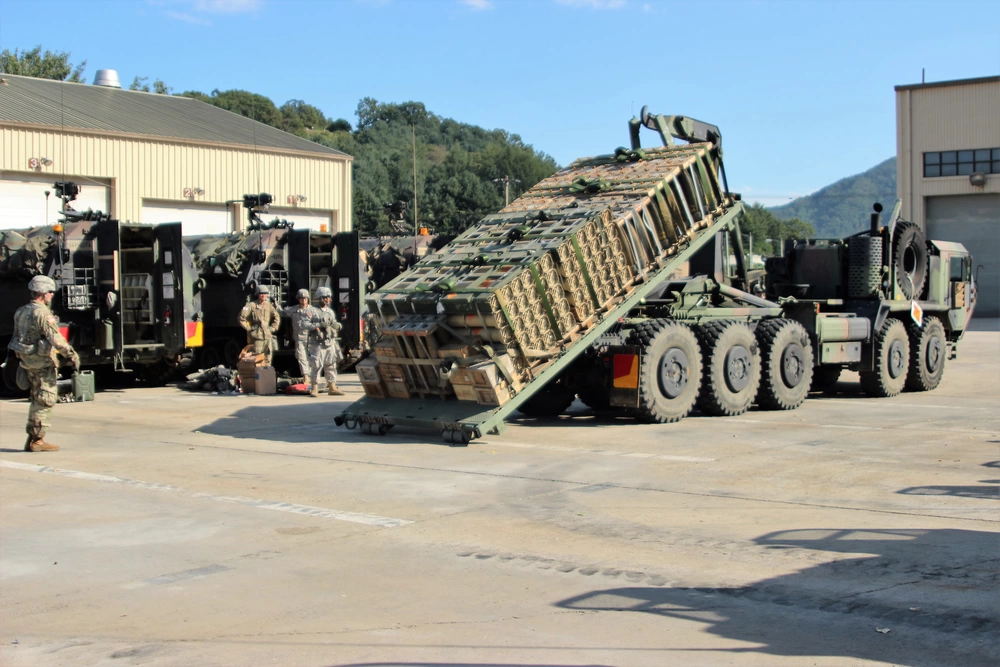Utilization of Unmanned Systems to Increase the Survivability of the Field Artillery
By MAJ David S. Jerome
Article published on: March 27, 2025 in Field Artillery 2025 E-edition
Read Time: < 10 mins

SMET During Sustainment Operations at the Joint Readiness Training Center
(SPECIAL THANKS TO 1SG BRANDON DETWILER FOR INSPIRING THIS ARTICLE.)
Introduction
The Field Artillery (FA) has demonstrated itself as the primary casualty producing weapon of the last century, earning the moniker “King of Battle” during the World Wars. As the technology of conflict has advanced in the post-war era, the FA branch has evolved along with it, becoming more accurate and lethal. The focus of the last two decades has been on accuracy, precision and range; enhancing the effectiveness of fires while reducing the total amount of munitions needed to service targets. This growth in capability has come at a cost: the increased lethality of the system has forced adversaries to focus on targeting FA units, while the logistical trains necessary to “feed” the guns has only increased in step with increases in range of systems. Integrating autonomous and semi-autonomous systems to reduce the manpower necessary to execute sustained operations is imperative for the future of the branch. Utilizing semi-autonomous vehicles to support casualty evacuation, ammunition and fuel resupply, reconnaissance and security will increase the survivability and lethality of artillery units while also reducing their manpower costs. Although seemingly divergent, these three Lines of Effort (LOEs) require a significant number of personnel to execute. Autonomous systems assisting in these operations would allow more personnel to focus on the execution of accurate and effective fires. Utilizing commercial off the shelf (COTs) products and retrofitting existing systems with readily available systems would be a fast, efficient way of reducing manpower requirements and increasing capability.
Background:
On June 24th, 1916, British Forces in France began a seven-day artillery barrage to break the stalemate of the World War I “Western Front.”1 Approximately 1.5 million shells were fired, and the Battle of the Somme began.2 Over the course of the War, it is estimated that 60% of the 9 million military casualties were caused by artillery alone.3 Now, over 100 years later, the Russo-Ukraine War shows that artillery—once again—reigns supreme, with 80% of the casualties on both sides estimated as being caused by indirect fire.4 As the conflict has progressed, the shell hunger ubiquitous with Large-Scale Combat Operations (LSCO) has once again emerged. To maintain current operations, Ukraine requires approximately 75-90,000 155mm rounds; that demand increases to approximately 250,000 for offensive operations.5 Early in the War, precision guided munitions (PGMs) were provided to compensate for the lack of available conventional artillery munitions, with the hope that each round would have greater effect per target. While initial successes occurred with PGM employment, Russian (RU) Forces quickly developed electronic warfare (EW) capabilities that saw only 1 in 19 rounds successfully striking their targets.6 The promise that fewer, smarter munitions would be the way of the future has been negated by the realization that massed, effective fires are just as critical now as they were in the past and will be in the future. It is evident that the logistical requirements for ammunition alone are already staggering without considering the fuel, food and water needed for vehicles and personnel in the firing unit. To account for the natural attrition of the battlefield, notwithstanding potential mass casualty events to both personnel and equipment, it is imperative that the focus of the artillery be on reducing manpower requirements for anything other than the firing of artillery. As mentioned, the FA has several critical friction points that must be addressed soon.
Current Challenges
There are multiple inhibitors to the to the execution of effective fires in a LSCO fight, but two warrant discussion: manpower shortages associated with Army force structure and active-duty end strength; procurement choke points between the development and fielding of critical systems. The first discussed will be personnel gaps. The Fiscal Year (FY) 2023 budget listed the active Army component at 452,000 Soldiers against a force design of 494,000 personnel.7 This shortfall of 42,000, or approximately 10% of the force, has caused ripple effects that hamper day to day operations in a garrison environment. The lack of personnel does not account for the attrition to the force that occurs from the multitude of factors inhibiting Soldiers from training, “…the battalion was only able to field about 70% strength due to numerous factors such as ETS [Expiration Time of Service], PCS [Permanent Change of Station] and medical.”8 At 70% effective strength, most operational units would be considered unable to execute their assigned tasks and essentially combat ineffective.

SMET During Sustainment Operations at the Joint Readiness Training Center
A howitzer battery—in a tactical environment— is required to execute effective 24-hour fires while sustaining and protecting themselves. These requirements are difficult to maintain with all assigned personnel, so they become nearly impossible when operating at 70% strength. Commanders are forced to choose between sustainment capacity and firing capability, and they will always choose the former but at great cost. An example would be the M1074/5 family of vehicles. A self-propelled howitzer battery is assigned six M1074s with each truck having the ability to carry 172 complete 155mm rounds.9 All six can bring over 1,000 rounds of 155mm to the fight, but these vehicles are rarely utilized due to manpower shortages; a significant loss in capability

Black Widow Data Sheet
The second challenge is the difficulty associated with fielding new equipment to the conventional force. The procurement system is categorized by a four-step process that is designed on long-term investments for the entire Department of Defense (DOD): Planning, Programing, Budgeting and Execution (PPBE). 10 While effective for evolutionary technological change over time, it faces issues with the rapid demand of new and innovative solutions common in a near peer fight. Even though the DOD has announced reforming the PPBE process, the changes—primarily focused on the planning, programming and budgeting phases—will not take full effect until 2028.11 This delta between needs at the tactical level and what is being provided for long term success is significant; the Soldier on the ground is being fielded equipment they needed yesterday but won’t help them tomorrow. An apt example is the primary means of communication in a cannon artillery battalion, the RT-1523E. A single channel radio that was initially fielded in 1998, weighs 8lbs and is notoriously fickle regarding range, encryption capability in the modern EW environment and power.12
Proposed Solutions:
The proposed solutions to these issues expand upon one another: a reform of the execution process of PPBE to allow rapid fielding of existing COTS systems for testing; the utilization of existing, unmanned systems to be fielded to compensate for logistical shortfalls affecting the FA branch. Automating legacy systems like the M1074 family of vehicles with driverless, remote capability would allow tactical units to increase their load carrying capacity into combat by a significant amount. To supplement that capacity, vehicles such as the Small Multipurpose Equipment Transport (SMET)13 and Black Widow Reconnaissance Drone14 would facilitate personnel evacuation, security support and reconnaissance operations. These autonomous systems, while seemingly mundane, would exponentially increase the survivability and lethality of artillery batteries and battalions.
As previously mentioned, massed effective fires will be decisive in LSCO. With the importance of FA on the rise, the likelihood of more assets being leveraged against them by the enemy has grown. “Cannon batteries and platoons survive with a combination of movement and dispersion. Dispersion over great distance creates challenges for movement of vehicles for sustainment.”15 The FA branch has relied heavily on the rearm, refuel and resupply point (R3P) method16 which is generally a forward logistics node that provides much needed supply. To facilitate a timely resupply, batteries must generally group their assets and meet at a singular location to receive all their needed equipment. As shown in Ukraine, the massing of both Fires and Sustainment assets close to the forward line of troops (FLOT) will quickly see both of those formations targeted and attacked. To mitigate the massing of assets, batteries with the following systems could prove decisive: [SMALL] Black Widow Drones for more efficient reconnaissance and security capability; [MEDIUM] SMETs to facilitate intermediate level sustainment and casualty evacuation; [BIG] automated ammunition and sustainment vehicles. These three systems would reduce total numbers of Soldiers needed to conduct sustainment, casualty evacuation and reconnaissance exponentially.
A scenario will illustrate the process envisioned:
- SMALL. Prior to the occupation of a battery firing point, the battery commander and his gunnery sergeants conduct reconnaissance.17 A Black Widow is launched by any of the three personnel to conduct an initial overview prior to movement onto the site. After occupation, these systems are either assigned to monitor key ingress and egress routes for potential hostile personnel or to conduct initial reconnaissance of future sustainment sites and firing points.
- MEDIUM. After the battery is in position ready to fire, it begins to provide fire support. After several minutes of intense firing, a platoon is running short on rounds and needs a resupply. Minutes later a SMET arrives at its position with the requested ammunition. After the unloading of ammunition is completed, the platoon receives counter battery fire, and a Soldier is wounded. The casualty report is radioed to the battery commander, and the casualty is loaded on the SMET which departs for the casualty collection point (CCP). When the SMET arrives, medical personnel stabilize the casualty and move with the battery first sergeant to an ambulance exchange point (AXP). 18
- BIG. Hours later the battery has expended a large amount of ammunition and fuel while conducting survivability movements. They are given a new location to move to but require a hasty resupply. The battery executive officer19 departs for the resupply point with a semi-autonomous PLS’ following him. He arrives at a location several miles to the rear where there are six pallets with his requested ammunition and fuel ready for pickup. The pallets are checked by himself or an additionally assigned Soldier and loaded onto the PLS. He then moves to a predetermined link up point that was observed earlier by a Black Widow and drops one platoon’s resupply before moving to the other platoon’s logistics point. The platoons willthen collect their equipment with internal ammunition trucks while the battery prepares itself for continuous operations. After resupply has been completed, the executive officer is able to report to the battalion logistics officer how much ammunition was distributed and what will be needed during the next supply pickup.
Conclusion
By utilizing autonomous and semi-autonomous systems to relieve personnel shortages affecting the active-duty Army, Soldiers could be better employed to support their primary functions. These systems would also increase the resilience of an organization by reducing additional workloads associated with sustaining and maintaining Field Artillery tactical units during LSCO. While not a panacea, the increased logistical capacity of artillery units could have a monumental effect on shaping conditions for successful Multi-Domain Operations.
Notes
1. David G. Chandler, ed., Dictionary of Battles: The World’s Key Battles from 405 BC to Today, 1. American ed (New York: Holt, 1987), 175.
2. Chandler, 175.
3. Paul Strong, Artillery in the Great War (Havertown: Pen and Sword, 2011) and its impact on the fighting is inadequately understood. Paul Strong and Sanders Marble, in this important and highly readable study, seek to balance the account. Their work shows that artillery was central to the tactics of the belligerent nations throughout the long course of the conflict, in attack and in defense.
4. Stephen Grey, John Shiffman, and Allison Martell, “Years of Miscalculations by U.S., NATO Led to Dire Shell Shortage in Ukraine,” Reuters, July 19, 2024.
5. Luke Nicastro et al., “Defense Production for Ukraine Background and Issues for Congress” (Congressional Research Service, September 16, 2024), 9.
6. Carlotta Gall and Carlotta Golovin, “Some U.S. Weapons Stymied by Russian Jamming in Ukraine,” New York Times, May 25, 2024.
7. Andrew Feickert, “The 2024 Army Force Structure Transformation Initiative” (Congressional Research Service, August 21, 2024), 9.
8.Christopher Lipscomb, “Putting The ‘Forward’ Back in ‘Forward Observer,’” Field Artillery Professional Bulletin, no. 4 (April 8, 2022): 32.
9. Preston Vance, “M777A2 FA Battalion Use of the Pallet Loading System,” United States Field Artillery Association, July 26, 2021, 2.
10. Jonathan Wong, “Patching the Pentagon’s Procurement Problem,” War on Rocks, September 24, 2015.
11. “Planning, Programming, Budgeting, and Execution Reform Implementation Report” (Department of Defense, January 16, 2025), iii.
12. “L3HARRIS SINCGARS RT-1523,” 2019.
13. “Autonomous SMET - Uncrewed Ground Robotic System.”
14. “Black Widow by Teal Drones.”
15. Headquarters, Department of the Army, The Field Artillery Cannon Battery, 11–14.
16. Headquarters, Department of the Army, Field Artillery Cannon Battalion.
17. Headquarters, Department of the Army, The Field Artillery Cannon Battery, 1-2.
18. Headquarters, Department of the Army.
19. Headquarters, Department of the Army, 1–3.
Bibliography
“Autonomous SMET - Uncrewed Ground Robotic System.” Forterra, n.d.
“Black Widow by Teal Drones.” Red Cat Company, n.d. Chandler, David G., ed. Dictionary of Battles: The World’s Key Battles from 405 BC to Today. 1. American ed. New York: Holt, 1987.
Feickert, Andrew. “The 2024 Army Force Structure Transformation Initiative.” Congressional Research Service, August 21, 2024.
Gall, Carlotta, and Carlotta Golovin. “Some U.S. Weapons Stymied by Russian Jamming in Ukraine.” New York Times, May 25, 2024.
Grey, Stephen, John Shiffman, and Allison Martell. “Years of Miscalculations by U.S., NATO Led to Dire Shell Shortage in Ukraine.” Reuters, July 19, 2024.
Headquarters, Department of the Army. Field Artillery Cannon Battalion. ATP 3-09.23, 2015. Headquarters, Department of the Army. The Field Artillery Cannon Battery. ATP 3-09.50, 2016.
Lipscomb, Christopher. “Putting The ‘Forward’ Back in ‘Forward Observer.’” Field Artillery Professional Bulletin, no. 4 (April 8, 2022).
Nicastro, Luke, Andrew Bowen, Brendan McGarry, Daniel Gettinger, Jennifer DiMascio, and Christina Arabia. “Defense Production for Ukraine Background and Issues for Congress.” Congressional Research Service, September 16, 2024.
“Planning, Programming, Budgeting, and Execution Reform Implementation Report.” Department of Defense, January 16, 2025.
“SINCGARS RT-1523.” L3HARRIS, 2019. Strong, Paul. Artillery in the Great War. Havertown: Pen and Sword, 2011.
Vance, Preston. “M777A2 FA Battalion Use of the Pallet Loading System.” United States Field Artillery Association, July 26, 2021.
Wong, Jonathan. “Patching the Pentagon’s Procurement Problem.” War on Rocks, September 24, 2015.
Author
MAJ David Jerome commissioned in 2014 from the United States Military Academy at West Point. He has served in both the conventional cannon artillery as a platoon leader, fire support officer and battery commander, and special operations as a fire support officer. He is originally from Alexandria, Virginia.

PLS Unloading Complete 155mm Rounds, Camp Hovey, Korea” Source (DVIDs): Jenko, Gabriel A, “A/1- 82FAR, 1ABCT, 1CAD Camp Hovey, South Korea,” 2016